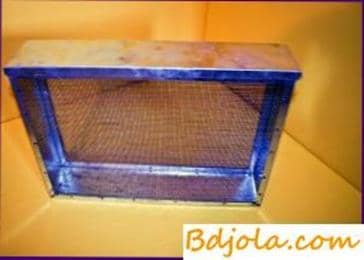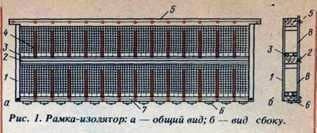
It is known that high honey gathering can be obtained from strong families with young uterus. For the artificial withdrawal of queens in the early period, I use a special frame-insulator.

Cross-section of the upper bar 15X25 mm, medium 12X25, bottom and side 6X25 mm. The rear wall is studded with a brass netting 1 with a 3X3 mm cell. Wooden partitions 2 mm thick, the frame is divided into 26 compartments – cells. The partitions 4 are pressed by feeding troughs 3 with a hole for the candy. In the upper and lower bars on both sides of each cell stuck pins 5. On the middle bar small nails strengthened two tin grooves 2.
Cut to the size of the cells, the window panes 8 are placed in a groove between the pins of each cell. Through the ears of the pins of the upper and lower laths a wire 7 is stretched, which keeps the glasses from falling out. To the bottom bar, opposite each cell with small screws are attached turntables 6 of textolite, protruding beyond the bar by 2 mm, these turntables support the glass of the lower row of cells.

Planks with sealed queen cells are inserted into the frame-insulator. Each mother is in a separate cell, on the one side covered with glass, and on the other – a common net.
Four to five hours after the selection of the uterus from the family-educator honeycomb with larvae (no older than 1 2 hours) I cut into strips, each of which contains a number of undamaged cells. On one side of the strip I cut the cells halfway and cut them into pieces, each containing a cell with a larva.
Such pieces of the honeycomb are glued with molten wax to the three slats in the places of marking the cell centers of the frame-insulator. Vaccination strips pre wipe with hot wax. At the time of work, I cover each bar with grafted larvae with a warm moist towel. The whole operation lasts no more than 30 minutes.
Then I put the straps in the frame on the lugs and immediately set them in the prepared window between the printed and open brood of the bezmokochnoy family-teacher. It is good to put honeycomb-pear mixture in a honeycomb.
Nest on all sides insulated. I feed the family daily with honey syrup. On the second and third day I check the frames and tear off all the fistulous queen cells.
In five or six days, when the queen cells are rebuilt and sealed, I take out the frame from the nest and take out of it three platters with queen cells. Hacksaw on metal (less concussions) cut out areas with unaccepted larvae. Planks with the best queen cells are inserted into the frame-insulator with the expectation that in each cell there is a mother bottle.
Of the 39 grafted larvae on three planks, the bees usually receive and rebuild 20-25. Putting all the cells of the insulator frame in the kandi feeders, I close them with glass flaps and put it in any strong bee family for ripening. On the 13th to 14th day, after the grafting of the larvae, the uterus emerges from the queen cells.
The rest of the measures for the removal of queens, as well as the formation of the layers, I conduct along the generally accepted technology.
Виды пчел фото. Слабая пчелиная семья весной.
Mothers and uterus